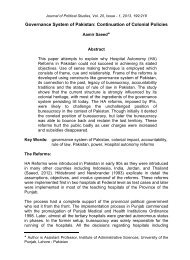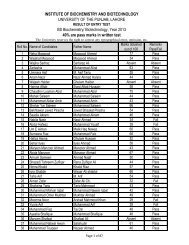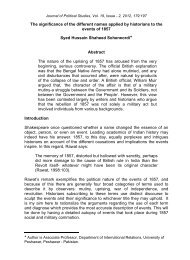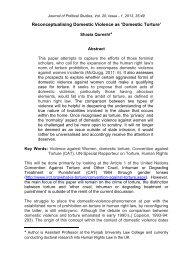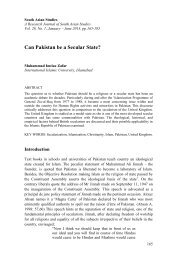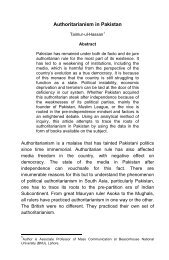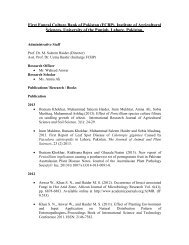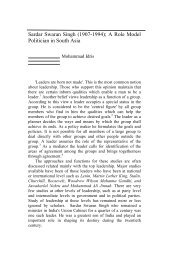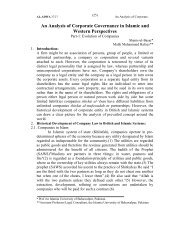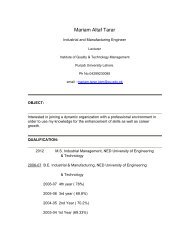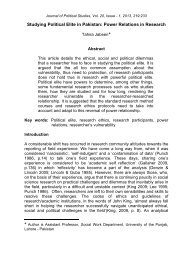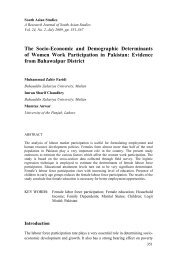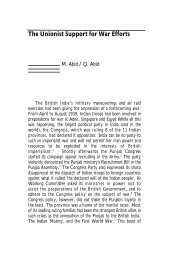pakistan geographical review 1954 - University of the Punjab
pakistan geographical review 1954 - University of the Punjab
pakistan geographical review 1954 - University of the Punjab
Create successful ePaper yourself
Turn your PDF publications into a flip-book with our unique Google optimized e-Paper software.
coastal area round about Karachi humidity is high but it is confined to a smad<br />
area and is much lower than is found in East Bengal. At Karachi <strong>the</strong> humidity<br />
is 50% throughout <strong>the</strong> year, being more than 60% during <strong>the</strong> day and 80%<br />
during <strong>the</strong> night in summer only.<br />
Soils.<br />
The soils <strong>of</strong> <strong>the</strong> two wings <strong>of</strong> Pakistan are also complementary in<br />
nature and reveal very diverse pr<strong>of</strong>iles. The soils <strong>of</strong> West Pakistan generally<br />
fall under' <strong>the</strong> group <strong>of</strong> Pedocals. Though <strong>the</strong>se soils are characteristic <strong>of</strong> a<br />
land with low and erratic rainfall, great extension <strong>of</strong> irrigation has made<br />
<strong>the</strong>ir extensive use possible. They are generally quite fertile. There are,<br />
however, certain areas which are suffering from injurious salts, a natural<br />
corollary <strong>of</strong> irrigation and dry climate.<br />
Soils <strong>of</strong> East Pakistan belong to <strong>the</strong> o<strong>the</strong>r category Pedalfers.<br />
They are mostly Pedzolic or still new laterites. There are large<br />
swampy areas. The effect <strong>of</strong> leaching is to a great extent neutralised<br />
by <strong>the</strong> annual renewal <strong>of</strong> silt over vast areas at <strong>the</strong> time <strong>of</strong> floods.<br />
Again while soil erosion is a great menace in many parts <strong>of</strong> West Pakistan<br />
like that <strong>of</strong> <strong>the</strong> Potwar Plateau, <strong>the</strong>re is no trouble <strong>of</strong> similar type in East<br />
Pakistan on account <strong>of</strong> <strong>the</strong> fact that <strong>the</strong> ground is generally moist and plant<br />
cover plentiful. But here we are faced with a different proposition. Rivers<br />
frequently eat away <strong>the</strong>ir banks and desert <strong>the</strong>ir channels. Land Utilisation<br />
problems here are, <strong>the</strong>refore, different from those in West Pakistan.<br />
Vegetation.<br />
The total estimated area <strong>of</strong> forests in Pakistan excluding <strong>the</strong> states is<br />
about 14,500 sq. miles which is about 6.4 percent <strong>of</strong> <strong>the</strong> total area <strong>of</strong> <strong>the</strong><br />
country. Of this West Pakistan has only 1872 sq. miles under<br />
forests. It works out to be abou t 3.2 percent <strong>of</strong> its total area. This percentage<br />
rises to about 16.7 in East Pakistan. It will be seen that although. both <strong>the</strong><br />
western and eastern wings are deficient in forest resources, this deficiency is<br />
very great in <strong>the</strong> west. East Pakistan has valuable timber and fuel wood<br />
resources. Out <strong>of</strong> a total annual output <strong>of</strong> 92,57,782 c. ft. timber in Pakistan,<br />
East Pakistan contributes 79,24, 000 c. ft. In addition it produces 1,34,20,900<br />
c. ft. <strong>of</strong> fuel wood out <strong>of</strong> a. total <strong>of</strong> 3,14,30,460 c. ft. There IS quite<br />
a good balance between timber and fuel wood. In West Pakistan <strong>the</strong><br />
production <strong>of</strong> timber is very inadequate and excluding Sind, even<br />
9



